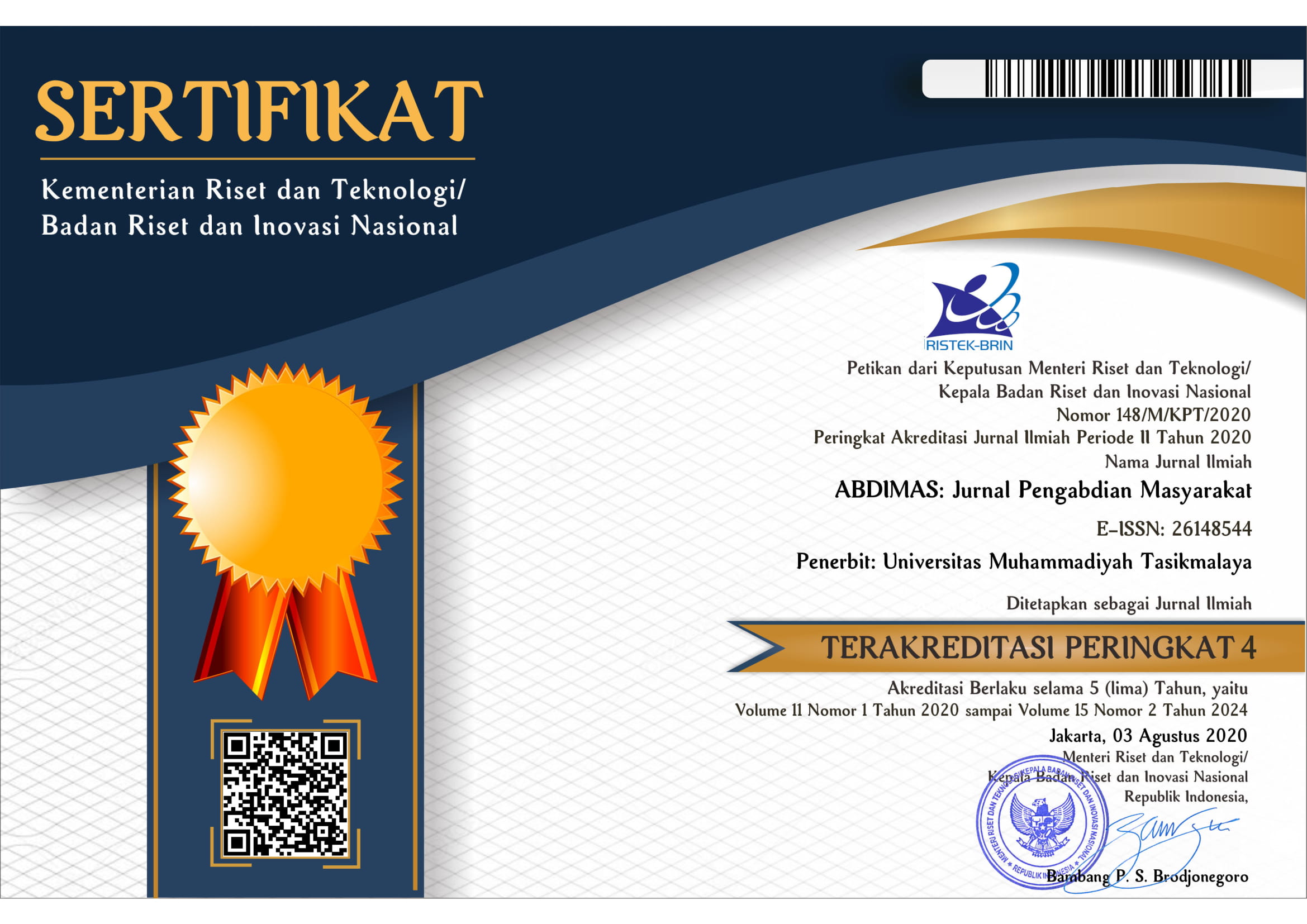Adoption of Rainwater Harvesting Technology and Drip Irrigation Automation by Akur Muda Farmer Group, Ngaglik District, Sleman Regency, Yogyakarta
DOI:
https://doi.org/10.35568/abdimas.v7i3.4909Keywords:
Drip Irrigation, Empowering, Internet of Things, Rainwater harvesting, Young farmers empoweringAbstract
The horticulture sector in Sleman Regency has great potential to be developed thanks to the fertile land at the foot of Mount Merapi. However, challenges of high-water availability and climate change, such as the El Nino phenomenon, hinder the growth and production of horticultural crops. Several technologies have been introduced and adopted to address these issues, including rainwater harvesting systems, drip irrigation, and the Internet of Things (IoT) for system automation. Implementing these technologies has resulted in significant adoption among young farmers, with 80% adopting rainwater harvesting systems, 35% drip irrigation, 15% IoT, and 10% adopting all three technologies together. Adopting these technologies is changing the mindset and behavior of young farmers, increasing their awareness and understanding of modern agricultural technologies. This facilitates more efficient and sustainable agricultural production and improves the quality and productivity of agricultural products. Thus, young farmers in Sleman Regency are a promising long-term investment in improving the quality of human resources in the agricultural sector, supporting their existence in the industrial era 4.0, and strengthening the sustainability of the agricultural system in the region.
Downloads
References
Fajar, G., Minarto, M., & Tamyiz, U. M. H. (2023). Rancang Bangun Sistem Irigasi Tetes dan Monitoring Kualitas Lahan Pertanian Tadah Hujan Berbasis Web. Journal of Information System Research (JOSH), 4(4), 1333–1342. https://doi.org/10.47065/josh.v4i4.3899
Indriyani, I., Arioen, R., Hendi Jaya, F., Mirnasari, T., & Beni Santoso, A. (2023). Pendampingan Inovasi Teknologi Pemanenan Air Hujan untuk Meningkatkan Teknologi Proses Agroindustri Hortikultura. SABAJAYA: Jurnal Pengabdian Kepada Masyarakat, 1(2), 1–5. https://doi.org/10.59561/sabajaya.v1i2.22
Jabbar, F. A., & Purnaningsih, N. (2022). Diseminasi Instalasi Fertigasi (Irigasi Tetes) Guna Menghemat Penggunaan Air untuk Pertanian di Kelurahan Beji. Jurnal Pusat Inovasi Masyarakat (PIM), 4(2), 90–97. https://doi.org/10.29244/jpim.4.2.90-97
Koehuan, V. A., Odja, M. O., Peli, Y. S., & Nampa, I. W. (2024). PEMBERDAYAAN EKONOMI MASYARAKAT BERBASIS TEKNOLOGI IRIGASI TETES DENGAN ENERGI HIJAU PADA KELOMPOK TANI. JMM (Jurnal Masyarakat Mandiri), 8(1), 1473. https://doi.org/10.31764/jmm.v8i1.21035
Kumar, J., Patel, N., & Rajput, T. B. S. (2016). Development and integration of soil moisture sensor with drip system for precise irrigation scheduling through mobile phone. Journal of Applied and Natural Science, 8(4), 1959–1965. https://doi.org/10.31018/jans.v8i4.1070
Liu, S., Guo, L., Webb, H., Ya, X., & Chang, X. (2019). Internet of Things Monitoring System of Modern Eco-Agriculture Based on Cloud Computing. IEEE Access, 7, 37050–37058. https://doi.org/10.1109/ACCESS.2019.2903720
Lúcio, C., Silva, C. M., & Sousa, V. (2020). A scale-adaptive method for urban rainwater harvesting simulation. Environmental Science and Pollution Research, 27(5), 4557–4570. https://doi.org/10.1007/s11356-019-04889-6
Nadzirah, R., Mas’udi, Ach. F. M., Indarto, I., Ernanda, H., & Joan Pamungkas, I. (2023). Application of Drip Irrigation System on Vanilla Cultivation. SPEKTA (Jurnal Pengabdian Kepada Masyarakat : Teknologi Dan Aplikasi), 4(2), 225–238. https://doi.org/10.12928/spekta.v4i2.8407
Nugroho, B. D. A., Ardhitama, A., Arif, C., Wijayanti, S. I., Al Adilah, A. H., Hadi, I. P., Annisa, H. N., & Sartohadi, J. (2024). The Effect of ENSO on Seasonal Rainfall Using the Monte-Carlo Bootstrap Method in the Southern Part of Java, Indonesia. Ecological Engineering & Environmental Technology, 25(3), 211–219. https://doi.org/10.12912/27197050/181175
Pratiwi, A., & Suzuki, A. (2017). Effects of farmers’ social networks on knowledge acquisition: Lessons from agricultural training in rural Indonesia. Journal of Economic Structures, 6(1), 8. https://doi.org/10.1186/s40008-017-0069-8
Rohmah, R. N., Supardi, A., Supriyono, H., Handaga, B., & Mulyaningtyas, A. (2023). Application of a Water Pump Semi-Automation Controller to the Irrigation System for Rainfed Rice Fields in Wonorejo Village, Sragen. ABDIMAS UMTAS: Jurnal Pengabdian Kepada Masyarakat, 6(1), 3760–3766. https://doi.org/10.35568/abdimas.v6i2.3214
Salam, A. (2020). Internet of Things for Sustainable Community Development: Introduction and Overview. In A. Salam, Internet of Things for Sustainable Community Development (pp. 1–31). Springer International Publishing. https://doi.org/10.1007/978-3-030-35291-2_1
Sartohadi, J. (2023). Water Conservation-Based Ecotourism Development for Sustainable Local Economic Development and Supporting the Borobudur National Tourism Strategic Area (KSPN). Jurnal Pengabdian Kepada Masyarakat (Indonesian Journal of Community Engagement), 9(3), 131. https://doi.org/10.22146/jpkm.80708
Sulistiono, E., Rahadian, R., Wilda Aniriani, G., Andrya, D., & Tri Megasari, M. (2022). Extension of the results of the water quality laboratory test in the lake, Wanar Village, Pucuk District, Lamongan Regency. ABDIMAS UMTAS: Jurnal Pengabdian Kepada Masyarakat, 5(22), 2542–2547. https://doi.org/doi.org/10.35568/abdimas.v5i2.2557
Suryaningrat, A., Kurnianto, D., & Rochmanto, R. A. (2022). Sistem Monitoring Kelembaban Tanaman Cabai Rawit menggunakan Irigasi Tetes Gravitasi berbasis Internet Of Things (IoT). ELKOMIKA: Jurnal Teknik Energi Elektrik, Teknik Telekomunikasi, & Teknik Elektronika, 10(3), 568. https://doi.org/10.26760/elkomika.v10i3.568
Suwati, S., Muanah, M., Huda, A. A., & Gunawan, A. (2022). Economic analysis of tomato cultivation on dryland with drip irrigation technique. Jurnal Agrotek Ummat, 9(3), 190. https://doi.org/10.31764/jau.v9i3.9767
White, B. (2012). Agriculture and the Generation Problem: Rural Youth, Employment and the Future of Farming. IDS Bulletin, 43(6), 9–19. https://doi.org/10.1111/j.1759-5436.2012.00375.x
Wulansari, N. K., Utami, D. R., & Minarni, E. W. (2023). Increasing the Variety of Vegetable Products Using Hydroponic Formulation Technology. ABDIMAS: Jurnal Pengabdian Masyarakat, 6(4), 4564–4569. https://doi.org/10.35568/abdimas.v6i4.4017
Yang, P., Wu, L., Cheng, M., Fan, J., Li, S., Wang, H., & Qian, L. (2023). Review on Drip Irrigation: Impact on Crop Yield, Quality, and Water Productivity in China. Water, 15(9), 1733. https://doi.org/10.3390/w15091733












